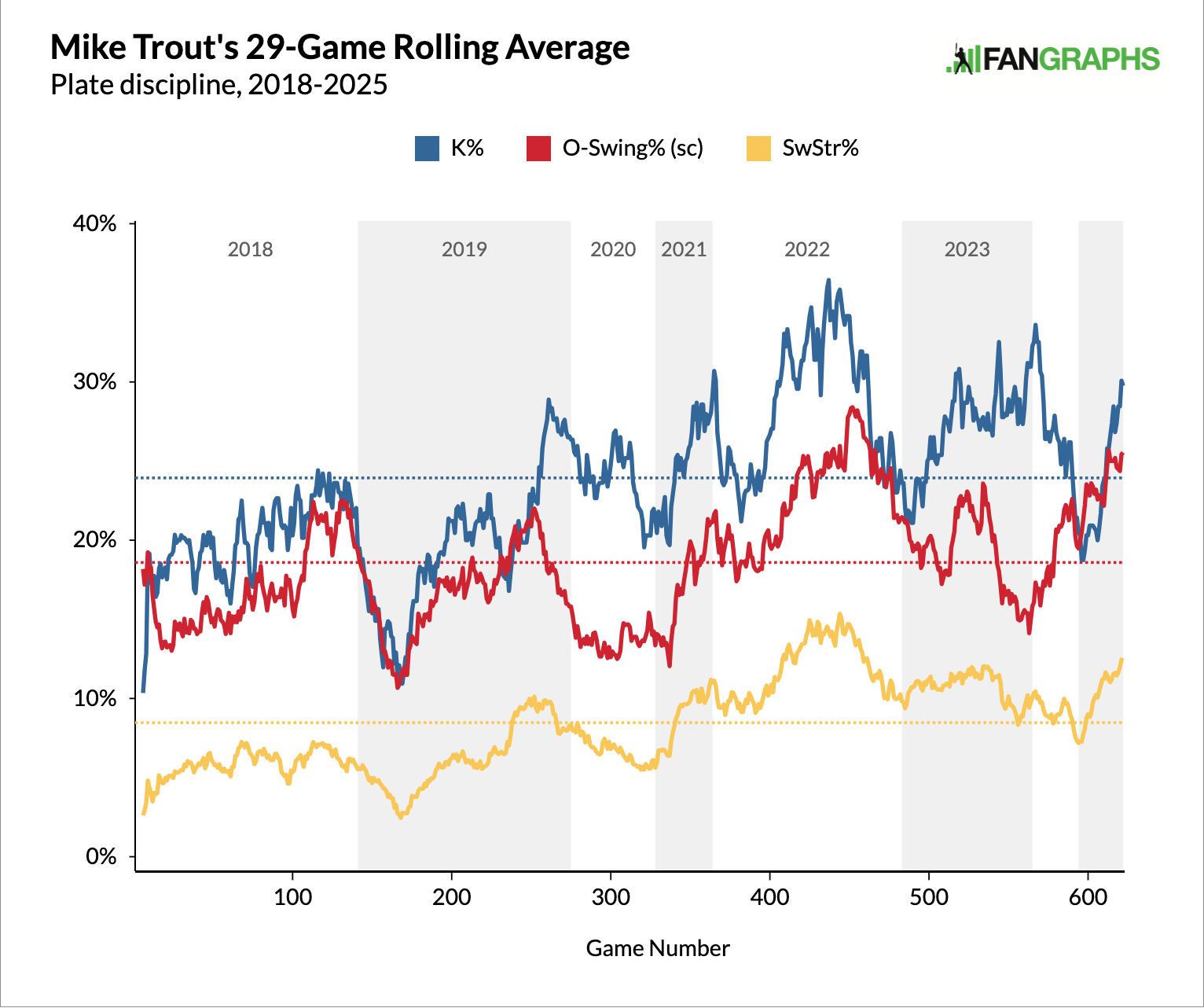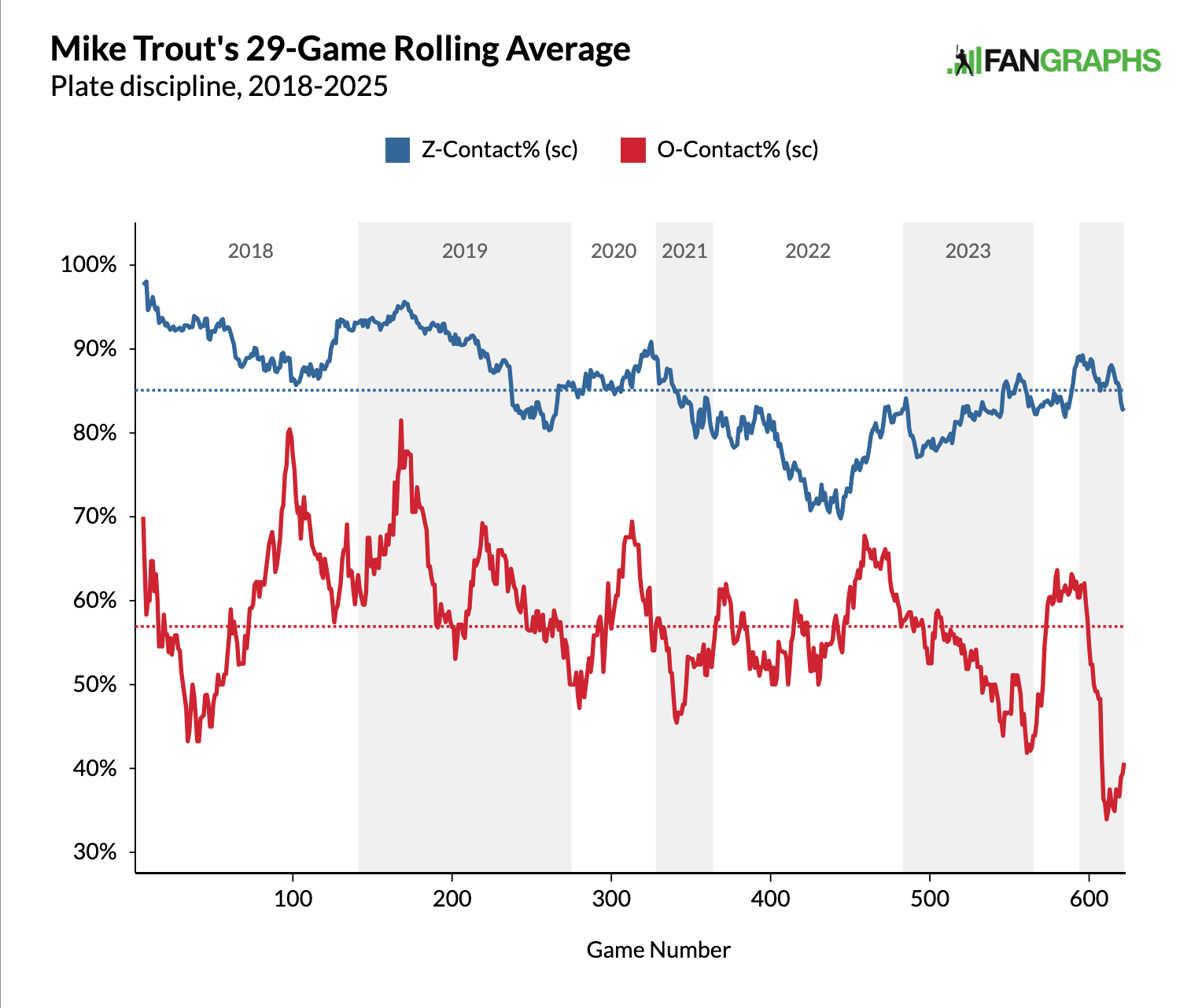Through the first five weeks of the 2025 season, the best you could say about Mike Trout was that he was at least healthy enough to play every day and was hitting a lot of home runs. However, the 33-year-old slugger departed Wednesday’s game against the Mariners with soreness in his surgically repaired left knee following a sprint to first base, and while he remained on the active roster for Thursday’s game, afterwards, the Angels placed him on the injured list with a bone bruise in the knee. That’s not a worst-case scenario, but it’s frustrating news on top of what’s already been a slow start.
Trout entered this season with more question marks hanging over his head than at any point in his 15-year career. After playing just 82 games in 2023 due to a fractured hamate bone — including just one after July 3 — he was limited to 29 games last year due to a torn meniscus in his left knee. He underwent surgery, but instead of the typical four-to-six week timetable, he needed nearly three months before beginning a rehab stint, and then played just two innings for Triple-A Salt Lake City before exiting due to discomfort in the same knee. After he flew back to Anaheim for further evaluation, he was diagnosed with another meniscus tear, requiring season-ending surgery.
Upon reporting to the Angels’ spring training facility in Tempe, Arizona in February, Trout met with general manager Perry Minasian and manager Ron Washington, and together they decided that the best course of action would be to move the 11-time All-Star center fielder to right field in order to save his body some wear and tear. Up until Wednesday, the plan seemed to be working; he’d played all 29 of the Angels’ games (matching last year’s total) with seven starts at DH interspersed with his appearances in right field. His .179/.264/.462 batting line, 96 wRC+, and 0.1 WAR aren’t anything to write home about, but he’s been hitting the ball hard on contact. His nine homers are enough to tie him for third in the American League alongside Tyler Soderstrom, Spencer Torkelson, and teammate Logan O’Hoppe, behind only Aaron Judge and Cal Raleigh.
Which brings us to Wednesday’s game against the Mariners in Seattle. In the first inning, Trout blooped a high sinker from Emerson Hancock into left field for a single, and made it as far as third base before the inning ended. In the third, he hit a slow roller to second base and turned on the jets in an effort to reach safely. According to Statcast, his sprint was at 29.7 feet per second, his fastest of the season, but he was out by half a step nonetheless. After returning to right field in the bottom of the third, he yielded to pinch-hitter Jo Adell with two outs in the fourth.
Trout explained after the game that while he felt fine after his dash to first, his left knee began to feel “weird” when he returned to right field. “When I started jogging in the outfield a little bit, I started feeling it a little more. Wanted to be smart about it,” he said. “Hopefully, it’s just a little scar tissue breaking up,” he later added. The Angels removed him from the game, Trout was checked out by a doctor, and he iced his knee and received pulsed electromagnetic field therapy.
Trout was not in the lineup for Thursday’s game against the Tigers, but he remained on the active roster, with Washington telling the media he was still being evaluated but was in good spirits. After the team’s 10-4 loss to Detroit, the manager announced that the team was placing Trout on the injured list. “He has a bone bruise, so we’re going to put him on the IL,” said Washington. “It’s not significant. But he needs rest.”
While the testing did not reveal structural damage, a bone bruise isn’t great news, particularly as it’s been preceded by a loss of cartilage in the joint via his meniscectomies. Generally, a lack of cartilage to cushion the joint raises the possibility of bone-on-bone grinding, which can be one cause of a bone bruise, particularly when there’s no major trauma involved. Given at least one description of a “jammed” knee, Trout’s left knee may have incurred enough force with the lunge on his final step to first base to have caused the bruise, but that it was enough to send him to the IL testifies to the fragile nature of the joint.
Per the Baseball Prospectus Recovery Dashboard, five position players have hit the IL with bone bruises in a knee since 2016, with absences ranging from 16 days to nearly four months:
Bone Bruises in Knees, Position Players
Effective Date
Player
Injury Type
Final Injury Description
Days on IL
6/6/17
Devon Travis
Contusion
Right knee bone bruise
117
8/9/17
Johan Camargo
Contusion
Right knee bone bruise
27
3/29/21
Kyle Lewis
Contusion
Knee bone bruise
22
6/23/24
Starling Marte
Contusion
Knee bone bruise
56
7/5/24
Jason Heyward
Contusion
Knee bone bruise
16
SOURCE: Baseball Prospectus Recovery Dashboard
That’s a mixed bag that includes a short outage for a player who previously had meniscus surgery (Lewis) and a long one for a player who (to the best of our knowledge) has never had knee surgery (Marte).
As Trout cools his knee and his heels on the IL, it’s worth a look at his struggle to stay above replacement level. While he was hardly in vintage form last year, his .220/.325/.541 line translated to a 139 wRC+; his 10 homers in 29 games put him on pace for 56, while his 1.0 WAR put him on pace for 5.6. He’s been much less productive this year, and the big thing that stands out thus far is his 29.8% strikeout rate. From 2012–19, he struck out just 21.2% of the time, and only once (in 2014) did he have a strikeout rate more than two percentage points above that (26.1%). As his playing time has gotten more sporadic due to injuries, his strikeout rate has fluctuated more; from 2020-24, he struck out 26.7% of the time, with a high of 28.7% in his 82-game ’23 season and a low of 21.4% last year.
Given the sample sizes in play, it’s particularly helpful to look at a rolling rate graph to find precedents for performance. Here’s one with Trout’s strikeout rate as well as his chase and swinging strike rates. All of these are interconnected, and all are higher than the seasonal rates we’ve seen before. He’s currently chasing 25.5% of pitches outside the zone, nearly a six-point increase from last year and his highest mark since his cup of coffee in 2011, and he’s swung and missed on 12.4% of his pitches, up over five points from last year, and about a point above his 2021–23 rate (11.3%):

What this graph illustrates is that Trout had such a stretch much longer than this in 2022, which right now looks like The Last Real Mike Trout Season, a 119-game campaign in which he hit .283/.369/.630 (176 wRC+) with 40 homers and 6.0 WAR but missed five weeks due to back inflammation caused by T5 costovertebral dysfunction. The mid-2022 peak of those rolling rates more or less coincides with the point at which he went on the injured list.
A look at Trout’s pitch-type splits shows that he’s above his career chase rates on all six of the pitch types he’s most commonly thrown. Given the volume, the biggest deal is that he’s chasing 14.6% of four-seamers and 25% of sinkers outside the zone; both of those are about double his 2023–24 rates, and above his career marks of 11% for four-seamers and 17.9% for sinkers.
His 31.7% chase rate on sliders (including sweepers) is more in line with his career marks and his recent fluctuations. While he’s hit .229 and slugged .521 against four-seamers, he’s whiffed on a career-high 30.8%; prior to 2022, he’d never whiffed on more than 22.4% of such pitches. He’s hit just .111 and slugged .278 on sinkers, down from .294 and .647 last season, albeit in pretty small samples (19 PA this season, 21 last season). He’s 0-for-18 against sliders and sweepers, with a 42.2% whiff rate.
Given his high chase and swinging strike rates, it’s worth taking a look at Trout’s rolling contact rates for in- and out-of-zone pitches. For the same time period as the previous rolling graph, we see that while he’s within relatively recent range for in-zone pitches, he’s really in the weeds on out-of-zone ones:

So that’s not great. For some more encouraging news, we shift to what happens when he makes contact. Perhaps because a few of his best seasons preceded the Statcast era — he was the MVP in 2014 and was the runner-up in the previous two seasons, exceeding 10 WAR in both — Trout has never dominated the Statcast leaderboards to quite the extent that Judge or Shohei Ohtani have except in the barrel rate department. His average exit velocities and hard-hit rates have both been in 99th-percentile territory at some points but have centered closer to the 90th percentile, with a low of the 69th percentile for EV and 74th for hard-hit. His barrel rates have often been in the 98th percentile or above, with a low of the 93rd. Percentile-wise, he’s below all of those currently, but he’s much closer to his norms in barrel rate, and still not that far off his Statcast-era averages in the other categories:
Mike Trout Statcast Profile
Season
BBE
EV
Pct EV
Brl%
Pct Brl
HH%
Pct HH
2022
300
91.6
99
19.7%
93
50.3%
97
2023
206
91.9
90
16.0%
99
51.5%
96
2024
82
89.2
89
17.1%
95
41.5%
95
2025
72
90.5
63
16.7%
90
45.8%
66
2015–25
2,744
91.3
15.7%
46.0%
Sample-wise, we’re far enough along that we can put some stock in those numbers. Exit velocity stabilizes at the 40 batted ball event mark and barrel rate at the 50 BBE mark; hard-hit stabilizes at the 80 BBE mark, so he’s short of that, but his rate doesn’t appear to be a departure.
Trout’s expected stats show he’s getting a particularly raw deal in the batting average department, but his expected slugging percentage is in line with his recent fragmented seasons. The lag between actual and expected numbers is very wide on pitches in the heart of the zone:
Mike Trout Expected Stats
Season
Split
PA
AVG
xBA
SLG
xSLG
wOBA
xwOBA
Whiff%
Brl%
2022
Total
499
.283
.265
.630
.583
.418
.395
30.2%
19.7%
2023
Total
362
.263
.275
.490
.523
.368
.389
29.3%
16.0%
2024
Total
126
.220
.271
.541
.591
.365
.405
20.5%
17.1%
2025
Total
121
.179
.248
.462
.577
.307
.373
30.1%
16.7%
2022
Heart
171
.327
.305
.784
.724
.468
.435
23.7%
24.8%
2023
Heart
141
.353
.377
.683
.775
.428
.487
21.1%
23.3%
2024
Heart
50
.320
.335
.860
.824
.491
.486
13.3%
24.4%
2025
Heart
55
.164
.290
.382
.625
.231
.383
13.7%
13.3%
2022
Shadow
248
.270
.257
.588
.545
.380
.361
27.9%
16.7%
2023
Shadow
151
.221
.219
.397
.368
.304
.294
30.1%
7.1%
2024
Shadow
58
.140
.230
.260
.411
.242
.330
24.5%
6.1%
2025
Shadow
48
.244
.253
.683
.653
.408
.398
34.3%
22.2%
SOURCE: Baseball Savant
On pitches in the heart of the zone, Trout’s actual performance has been bad — nine runs below average, uncharted territory for him — but while his contact in that area hasn’t been up to his recent standards, it’s been much better than his raw slash line suggests. He’s actually doing fine in the shadow zone, the pitches on either side of the border of the strike zone, at six runs above average, which is as good or better than he did during some vintage seasons (2016–18).
Neither his current injury nor his statistics thus far suggest things are particularly rosy in Troutland. But while we shouldn’t expect him to suddenly revert to MVP form, his underlying metrics suggest his performance hasn’t been as bad as his numbers look at this juncture. We can hope — again — that this won’t be a long absence, and that as he gets more playing time upon returning, he’ll show us something closer to his productive-when-available 2023-24 levels. Fingers crossed.















